 Back to selection
Back to selection
Shutter Angles
Conversations with DPs, directors and below-the-line crew by Matt Mulcahey
“Which One is the Real Doll and Which One is the Actress?” DP Peter McCaffrey on M3gan
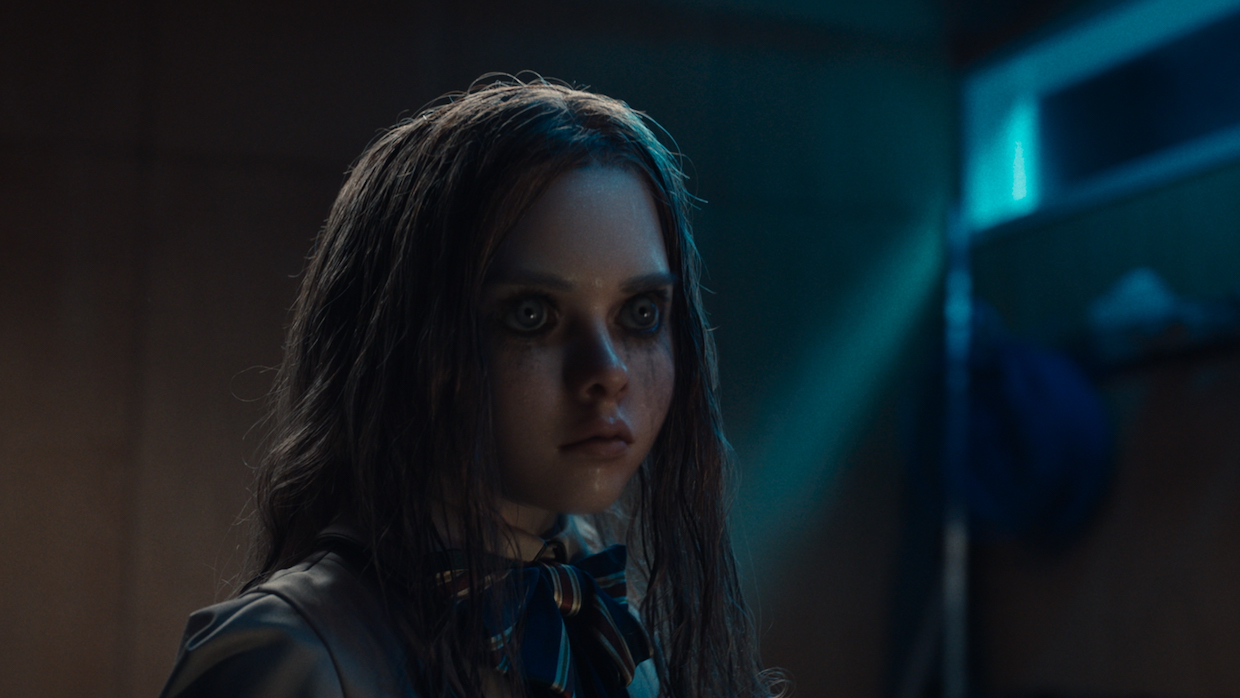 M3gan in M3gan
M3gan in M3gan When Peter McCaffrey left the processing lab at New Zealand’s National Film Unit in the early 1980s to become a freelance camera assistant, his bosses told him he’d be asking for his job back in two weeks. There was no such thing as a film industry in New Zealand, they warned.
35 years later, McCaffrey still hasn’t looked back. Climbing the ranks from clapper loader to focus puller to camera operator, McCaffrey has built an impressive resume of large-scale credits including The Lord of the Rings trilogy, Dawn of the Planet of the Apes and Thor: Ragnarok. Now, he has taken another career leap with M3gan, his first feature as main unit director of photography. McAffrey spoke to Filmmaker about bringing the titular killer doll to life and how his career has been like a game of snakes and ladders.
Filmmaker: Is moving into the role of cinematographer something you’ve been contemplating for awhile?
McCaffrey: It’s a funny path. I look back on some of my earlier television work, and even back as a 1st AC starting out in New Zealand you were given opportunities to shoot things because they couldn’t afford another unit. So, if they needed a drive-by or an insert done or something like that, as a 1st AC in the late ’80s and early ’90s you’d be sent off to do it by yourself. Then I moved into more traditional operating roles on some large shows and worked with some amazing cinematographers: John Toll, Larry Sher, Don Burgess, Michael Seresin, Mandy Walker, Pete Menzies Jr. After operating for 25-plus years, I decided to hang the Steadicam up and put it out there a little bit that I wanted to start to shoot things. I managed to get a few good 2nd unit DP roles on Mortal Kombat and a Netflix show, Cowboy Bebop, and I shot a short film for a long-time actress friend in London, Kerry Fox.
In some ways, M3gan really came along as a result of COVID. They were looking originally to shoot in Montreal, but COVID obviously shut the world down and [M3gan director] Gerard Johnstone was New Zealand-based. New Zealand had zero COVID cases at that time, so we were able to shoot the film in normal shooting conditions: no masks, no nothing. So, I was in the right place at the right time, and I had a few connections with a few producers through [M3gan production companies] Blumhouse and Atomic Monster. Gerard fortunately decided to roll the dice on me, and I’ll be forever grateful for him doing that.
Filmmaker: And you wrapped just ahead of a COVID wave hitting New Zealand?
McCaffrey: Right. We’d already had our first wave and our first lockdowns before that. I was involved as an operator on the Amazon Lord of the Rings series, which we only shot for maybe four to six weeks in early 2020 before we went into our first major lockdown. M3gan fell into a little window where New Zealand had opened up again and had eliminated COVID in the community. Then, within three or four days of wrapping principal [on M3gan], we went into lockdown again. So, it was this magical little bubble.
Filmmaker: I interviewed X cinematographer Eliot Rockett, a film you operated on, and he said for a movie that size he had an amazing crew because a lot of people had been on the Avatar sequels for like two years and just wanted to get off the soundstage. How did you avoid Avatar? Seems like every crew member in New Zealand was conscripted into service.
McCaffrey: (laughs) I know a lot of the Avatar crew, even going back to the original one. I’ve been asked a couple of times to be involved and it just hasn’t worked out, timing-wise. I also don’t think I was in that head space of wanting to lock myself into a long-term operating position on Avatar with the transition into DP work.
Filmmaker: That’s always a scary jump when you’re moving up a position and it’s something you’ve dealt with multiple times in your career, starting out as a 2nd AC and moving to 1st AC and then to operator. When you do that, you’re basically turning down all these great opportunities in your old role to hang out your shingle all over again.
McCaffrey: I always say it’s a game of snakes and ladders. You start climbing the ladder as a 2nd AC, then you want to become a 1st, so you slide all the way down that snake and start climbing again. I’m not saying I’m never going to operate again—I love that role—but if I’m going to get the opportunity to keep leading the charge [as a cinematographer], I’ll certainly be looking to do that.
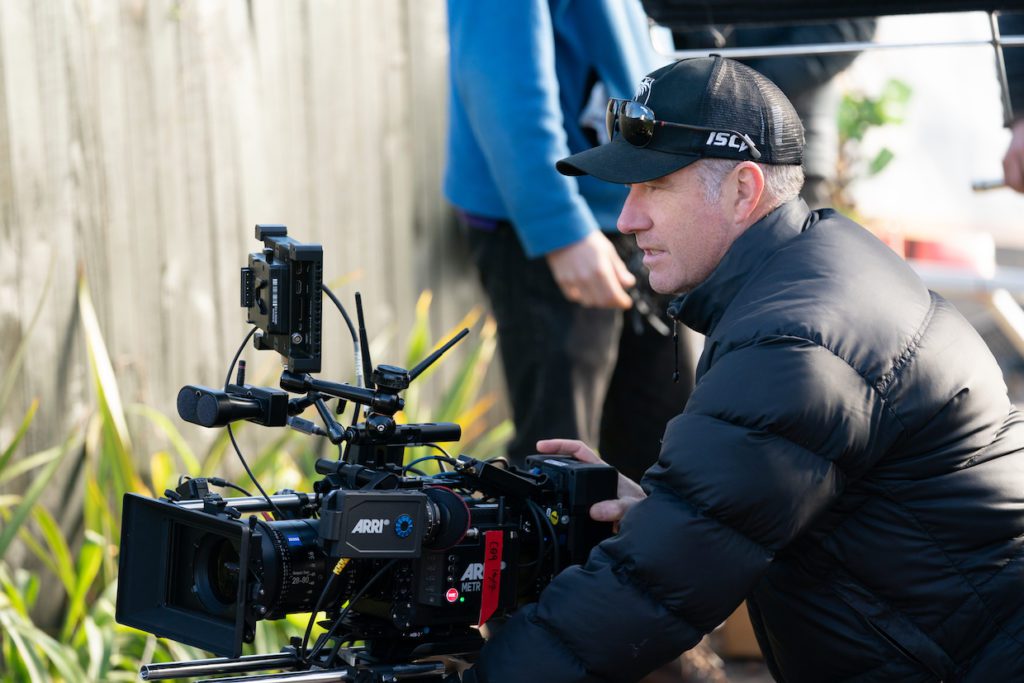
Filmmaker: What is the biggest adjustment when you make that leap? You certainly know about composition and coverage after years as an operator. Is it the lighting component of the job?
McCaffrey: I’m a true believer that you naturally, through osmosis, take in things by observing and watching people. You’re not in charge and you’re not placing and pointing the lights, but through the repetitive nature of what we do in our business, when you see so many masters of cinematography doing their craft day in and day out as an A Camera operator on the front line, you absorb a lot. I certainly don’t fear being on a film set and managing the floor is something that’s second nature, having done it for so long as an operator. On the lighting side of things, I know how I want to light something, but I may not know the best tool in the toolbox to use for that and that’s where you’re relying on the experience of your gaffer to help you out.
I actually think the single biggest adjustment is the preproduction stage. As an operator, even on a Marvel movie or something [of that size], you’re lucky to be turning up with five days prep; sometimes it’s less. So, you haven’t gone through that conception into realization process and dealt with how to put your ideas forward, how to approach your first meeting with a production designer and navigating those relationships—even, I suppose, to have to pitch to secure the project. I had interviews as an operator, but at a certain point you’re just getting recommended by someone and roll onto another show with a DP you haven’t worked with before based on that.
Filmmaker: Let’s talk about that preproduction process for M3gan. You’re using various techniques ranging from animatronics to puppetry to actresses in costume to bring the doll to live. Was the film heavily storyboarded?
McCaffrey: There were storyboards. Practical walkthroughs became a big thing as well with our stunt coordinator just to figure out the logistics of changing between an animatronic to a human playing that role and what we could and couldn’t get away with. It was a learning curve for everyone, things like whether we could just put the animatronic on some sort of dolly and make it feel as though it was moving like a robot, or would that look too stiff?
Filmmaker: Because of production’s move from Montreal to New Zealand, did you have time to test as much as you wanted or did some of the logistics get found out on set?
McCaffrey: (laughs) The latter. We had maybe half a day of camera/lighting looks tests with M3gan before we started shooting. It really evolved through the whole project and the animatronic team was constantly evolving what they could and couldn’t provide. At the end of the day, they did an amazing job.
Filmmaker: Is the breakdown basically if M3gan’s body isn’t moving too much it’s the animatronic, but if she is physically moving in a wider shot, it’s an actress with a mask?
McCaffrey: Yeah, pretty much. Mid shot to extreme closeups were all animatronic as much as we could get away with for numerous reasons. They’d obviously spent money on the development of the doll itself and there was a desire to do as little CG as possible and to make everything as real as possible. Then, as soon as M3gan has to stand and walk across the room, it’s our actress [12-year-old Amie Donald]. Coming across Amie was one bit of good luck from the production moving to New Zealand. She was just phenomenal in what she was able to do. The person they had lined up in Montreal may have been equally as capable, I don’t know, but a few things fell into place on this movie that created a little bit of magic and Amie was one of them.
Filmmaker: How much did the plan shift once Amie was cast and you found out she could dance, flip, run on all fours, etc.?
McCaffrey: It became an ongoing conversation. There was still a limitation to what she could do through the face mask. Her blinks and her mouth movements through the mask were different [from] the animatronics. So, if something with Amie was going to need specific face movement, that became a total CGI face replacement in post to make it look like the animatronic M3gan. Like any project, it became a budget-driven thing. There was a certain budget allocated for face manipulation on our actress, so it was just trying to pick the times where we wanted to make something flow rather than being forced to do something in the cut.
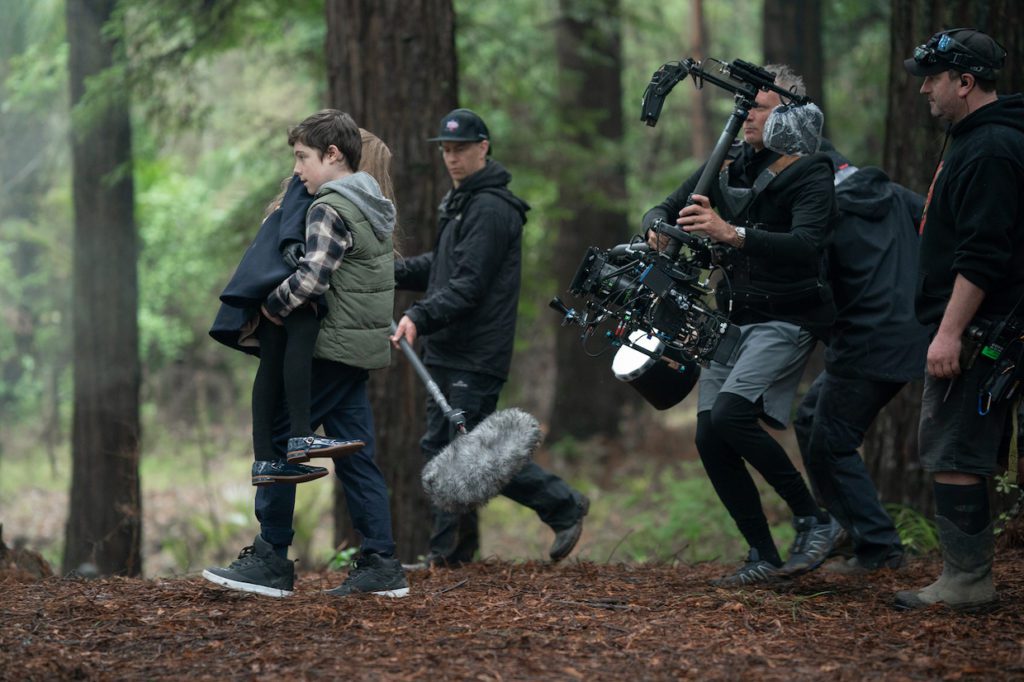
Filmmaker: Were there multiple animatronic versions of M3gan?
McCaffrey: You’re going to test my memory now. We had one true hero, then we had a lightweight one that was rigid for being carried around in the forest. We had one we could throw around and be a bit more aggressive with for when the dog attacks and things like that. We certainly couldn’t do that with our hero. So, from memory, we had one true hero, let’s call it a B-model, then a rigid and a lightweight version. So, I think we had four and there may have been a spare head floating around too.
Filmmaker: How heavy was the hero version? Could a single person pick it up and move it, or was it a whole ordeal to cart it around from shot to shot?
McCaffrey: The animatronic was heavy, definitely a two-person lift. With the dress, you could extend the length of what you could get away with a little bit, but the true animatronic, as far as I remember, had no leg movement and the arms had to be puppeteered by rods. So, the animatronic portion was really for facial expressions, eye movement and mouth movement.
Filmmaker: Were there certain qualities of light or camera angles that you couldn’t get away with when shooting M3gan?
McCaffrey: One of them looked slightly more plastic than the others, which was a lot more reflective. So, it was a little bit of makeup to take that shine off if we were using that one. The hero one was pretty amazing, really. The facial expressions were quite incredible and quite off-putting and scary at times. Going back to our only test day, I remember lining up two of the dolls and Amie dressed as M3gan, then taking some stills and some screengrabs. That night, I cropped them so you couldn’t see the cables coming out of the bottom of the animatronic’s skirt and then said, “Alright, which one is the real doll and which one is the actress?” And it was pretty hard to tell the difference between them. So, just from that half day of camera testing, we knew we had something, because it was very hard to tell which was real. We did have to watch out for shadows from the puppeteers, though. As a result, we headed down a path of softer sources rather than a traditional horror film with hard sources and hard shadows.
Filmmaker: Did you use any on-camera filtration for the doll?
McCaffrey: I carried black Glimmerglass and used that at times on the animatronic and also on some of the cast, depending on the scenes.
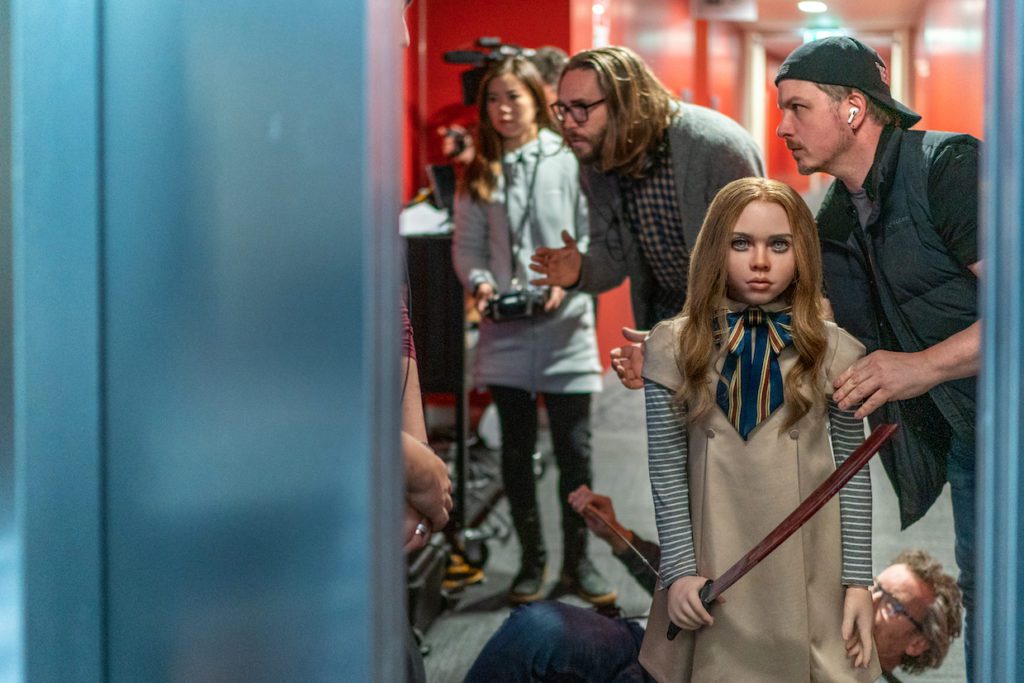
Filmmaker: I’ve seen behind the scenes shots from the original Child’s Play where the sets are built a few feet off the stage so that the puppeteers can operate from underneath. They also had to have a place to hide all the hydraulics and cables. I don’t know how far animatronics have come in 30 years, but did M3gan still need all that cabling?
McCaffrey: Yeah, it still needed to be plugged into a master computer for the mouth to move, but it wasn’t restrictive in any way. We didn’t have to build up sets for the puppeteers, who were usually lying on their backs with an arm twisted around their neck to make something on M3gan move. That’s something they’re very used to and good at doing, and they have reverse monitors so they can see the mirror image of what the camera is seeing.
Filmmaker: I also remember the Child’s Play effects team saying that the most difficult things to get the Chucky doll to do were related to fine motor skills, like picking up a kitchen knife. What was the most difficult action for the animatronic M3gan?
McCaffrey: Probably similar things. The physical hand movements and walking obviously were not things we could do with the animatronic. You’ll notice in the crayon drawing scene that the crayon is almost gripped like a killer doll with a knife in its hand rather than a pencil through the fingers. It’s just a round-handed grip rather than a finger grip on the crayon. Dexterity in the fingers was probably the thing that we battled the most.
Filmmaker: For close-ups of the doll’s hands, like when M3gan plays the piano, was there some sort of latex hand covering that an actor could wear?
McCaffrey: Yep, like long gloves.
Filmmaker: There’s a medium shot where M3gan reaches out and touches Allison Williams’ face. So, that’s the animatronic and then someone’s hands are in gloves coming out of the bottom of the frame?
McCaffrey: Yep. Quite often we’d have the animatronic with its real arm extended, which had no finger movement, then a second arm or hand would come into frame controlled by a puppeteer who was hiding on the floor.
Filmmaker: One of my favorite parts of the movie is the Perpetual Pets commercial at the opening. That seemed like it would be fun to do.
McCaffrey: The honest truth is I didn’t shoot that part of the project. It was originally in the script, it was originally scheduled and, as the reality of how much we had to get done in our 30-day window was put on paper, that was then cut from the script and placed in a separate side schedule, which Simon Raby shot as part of four or five days of pickups in New Zealand.
Filmmaker: Was that side schedule part of the reshoots that were done to assist in getting a PG-13 rated version of the film? Or were those an additional set of pick-ups?
McCaffrey: No, there was just the principal photography, then about four or five days of pickups back here in New Zealand that Simon shot, then a little bit in North America because Violet McGraw [who plays the orphaned niece of roboticist toy developer Williams] was unable to travel back out to New Zealand for the reshoots. So, there are a couple of scenes in the movie where there’s some of my original cinematography, some pickups in New Zealand with Allison and other cast, then some pickups shot in Atlanta with Violet. I take my hat off to the extra bit of photography they did because it was the icing on the cake that the project needed.
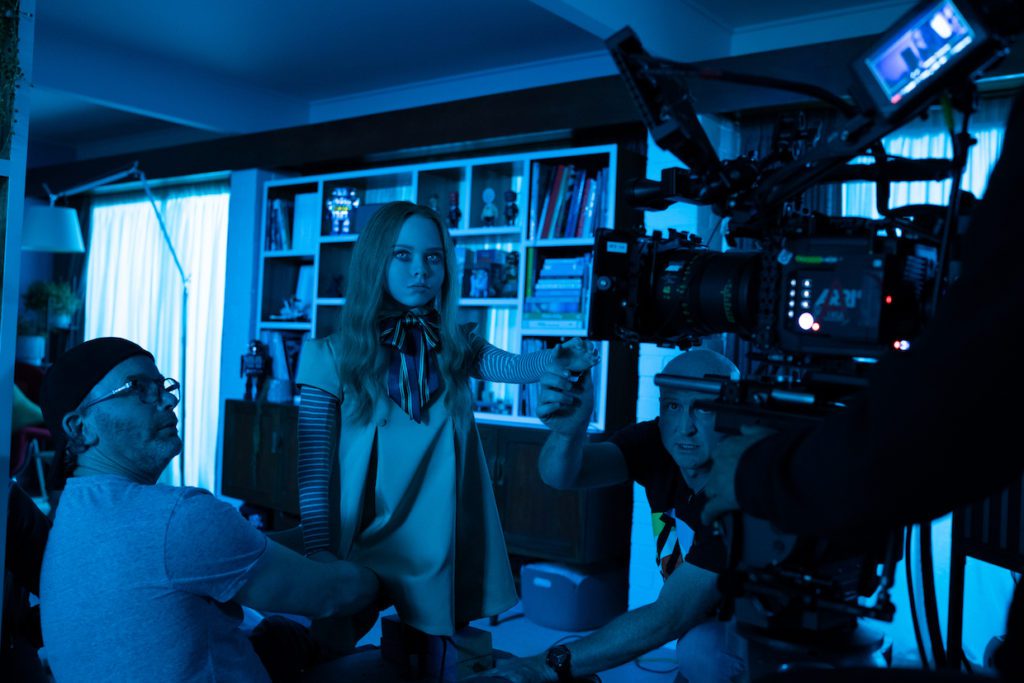
Filmmaker: Let’s talk about the night interiors at Williams’ house, because I love how you use these blue curtains.
McCaffrey: In our half day of testing, my gaffer and I were deciding on how blue to go with our blue. We certainly spent a bit of time with our production designer Kim Sinclair as well deciding on the texture of those shears. As I touched on earlier, I was definitely going for a more natural look with softer shadows than your traditional thrillers or horrors. For our night exterior work, we used a lot of SkyPanels, which I love, and where we needed some more punch we used 18Ks with Steel Blue and either a half or quarter CTB on top of that. I think my gaffer talked me into going half CTB rather than quarter and I kept saying, “Have we gone too far? It’s so blue.” Then, like anything, you naturally just become accustomed to it. That also led us to using contrasting colors, which is a look that I love, with something quite blue and then a warmer practical lamp or a sodium [streetlight] in the background. Inside the house, we had SkyPanel S360s, S60s and S30s. Most of, if not all, the night interiors were shot day for night because of the hours [you’re restricted to] with child actors. So, we had to use black tents outside, though we were limited because we didn’t have the budget to do massive tenting. We probably had four to six foot maybe of depth.
Filmmaker: You talked before about the process of preproduction being one of the biggest adjustments in your shift to the role of cinematographer. Another part of that process is the creation of LUTs. I believe you shot with Arri Alexa LF and Signature Primes. Tell me about designing LUTs for that combo.
McCaffrey: Yeah, we used the LF and the Signature Primes. I was really fortunate that my DIT Nina Chadha was down here. She’s based in America, but she was in New Zealand working on Cowboy Bebop on main unit and I was doing the 2nd unit. We developed a relationship with me trying to match main unit work and getting files and looks and things from her. Then I managed to keep her in the country to help us on M3gan. We talked about different looks and different styles, and she went away and created a group of LUTs that we then applied to some test footage that I shot by myself one night with a couple of friends around my place. We dialed in two to three looks that we were going to carry for the movie. The main LUT we used was nicknamed Warm Dark, which was a little bit of warmth and a little bit of contrast in everything, but nothing major going on. The Signature Primes seemed to have a really good look to them to start with. For the voiceover flashback stuff that leads into [Williams’] scene in the lab where she’s talking about what her boss should say at the pitch meeting, we created a different LUT, which was basically a very saturated, high contrast Rec709. We called that one “Pop,” and everything had a lot more lift and a lot more of a glamor look to it. The hospital room sequence after (Violet McGraw’s character Cady) has been in the car accident was what we nicknamed “Cool Dark,” but I think that may have been the only time we went to a slightly cooler look.
This was the first step in another learning process for me. I’m absolutely over the moon with the result and the team of people we had to achieve that result. We all joined this business to make movies that people go and see and enjoy and, in this day and age, to get the theatrical release and to get a positive response to the project is a real joy. And to have worked on the project with a group of technicians and crew that I’ve known for 20-plus years is just an added bonus.
